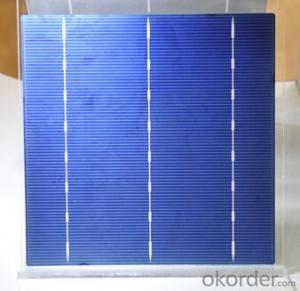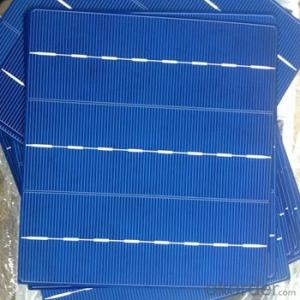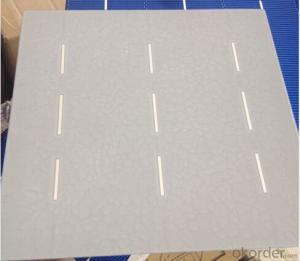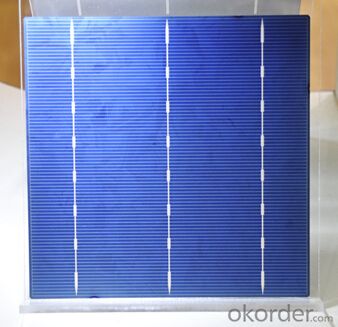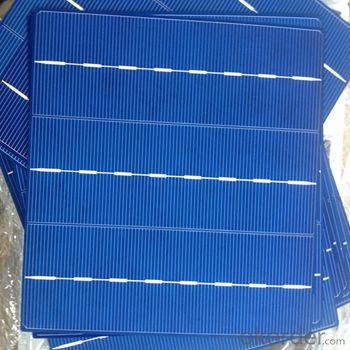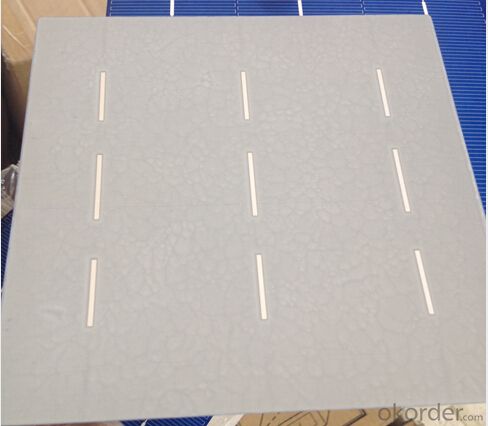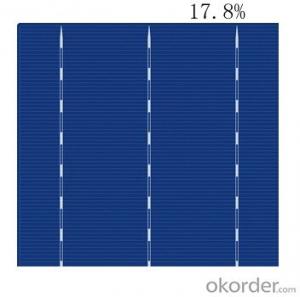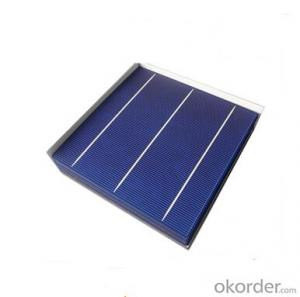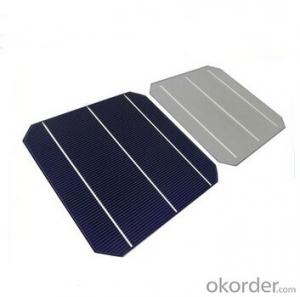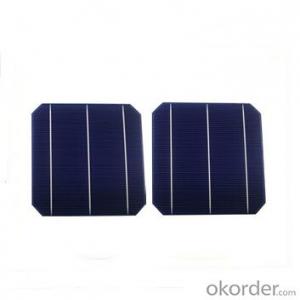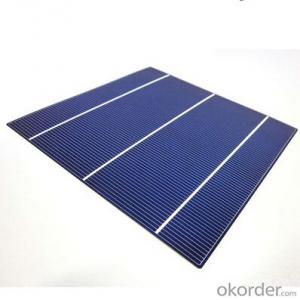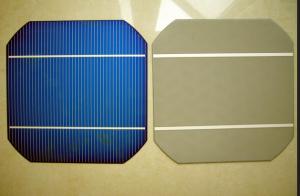Inkjet Printed Solar Cells - China Wholesale A Grade High Efficiency Polycrystalline Solar Cells with Low Price
- Loading Port:
- Shanghai
- Payment Terms:
- TT or LC
- Min Order Qty:
- 5000 pc
- Supply Capability:
- 8000000 pc/month
OKorder Service Pledge
OKorder Financial Service
You Might Also Like
Polycrystalline Silicon Solar Cells:
Solar cells is made by solar wafer, it has three categories of solar cell right now, monocrystalline polycrystalline and thin film,These cells are entirely based around the concept of ap-n junction, which is the critical part of solar module, it is the part that can convert the light energy into electricity, the thickness is from 180um to 200um, with even busbars to conduct electricity, textured cell can decrease diffuse reflection; they are often electrically connected and encapsulated as a module. Photovoltaic modules often have a sheet of glass on the front (sun up) side, allowing light to pass while protecting semiconductor wafers from abrasion and impact due to wind-driven debris, rain, hail, etc. Solar cells are also usually connected in series in modules, creating an additive voltage. Connecting cells in parallel will yield a higher current;With high quality and stable quality. Our Cells can greatly improve the performance of Solar Modules.
Polycrystalline Silicon Solar Cells Advantage:
• High efficiency and stable performance in photovoltaic conversion.
• Advanced diffusion technique ensuring the homogeneity of energy conversion efficiency of the cell.
• Advanced PECVD film forming, providing a dark blue silicon nitride anti-reflection film of homogenous color and attractive appearance.
• High quality metal paste for back surface and electrode, ensuring good conductivity, high pulling strength and ease of soldering.
• High precision patterning using screen printing, ensuring accurate busbar location for ease with automatic soldering a laser cutting.
Applications of Polycrystalline Solar Cells
Assemblies of photovoltaic cells are used to make solar modules which generate electrical power from sunlight, as distinguished from a "solar module" or "solar panel". A solar array generates solar power using solar energy.
Packaging & Delivery of Polycrystalline Solar Cells
Carton Box Package and Deliver by air. It should be noticed that it should be avoid of water, sunshine and moist.
Specification:
Mechanical data and design |
Format - 156 mm × 156 mm ± 0.5 mm |
Thickness- - 200 μm ± 20 μm |
Front (-) - 1.4 mm bus bars (silver),blue anti-reflection coating (silicon nitride) |
Back (+) - 2 mm wide soldering pads (silver) back surface field (aluminium) |
Temperature Coefficient of Cells |
Voc. Temp .coef.%/K -0.364%/K |
Isc . Temp .coef.%/K +0.077%/K |
Pm. Temp. coef.%/K -0.368%/K |
Electrical Characteristic |
Efficiency (%) Pmpp (W) Umpp (V) Impp (A) Voc (V) Isc (A) |
18.00% 4.380 0.538 8.141 0.634 8.740 |
17.90% 4.356 0.538 8.097 0.634 8.725 |
17.80% 4.331 0.537 8.065 0.633 8.710 |
17.70% 4.307 0.536 8.035 0.632 8.695 |
17.60% 4.283 0.535 8.006 0.631 8.680 |
17.50% 4.258 0.534 7.974 0.630 8.665 |
17.40% 4.234 0.533 7.944 0.629 8.650 |
17.30% 4.210 0.532 7.914 0.628 8.635 |
17.20% 4.185 0.531 7.88 -- 0.627 -- 8.620 |
17.10% 4.161 0.530 7.851 0.626 8.605 |
17.00% 4.137 0.529 7.820 0.625 8.590 |
Intensity Dependence |
Intensity [W/m2] Isc× [mA] Voc× [mV] Pmpp |
1000 1.00 1.000 1.00 |
900 0.90 1.000 0.90 |
800 0.80 0.99 0.80 |
500 0.50 0.96 0.49 |
300 0.30 0.93 0.29 |
200 0.20 0.92 0.19 |
IV Curve

Solar Panel Images:
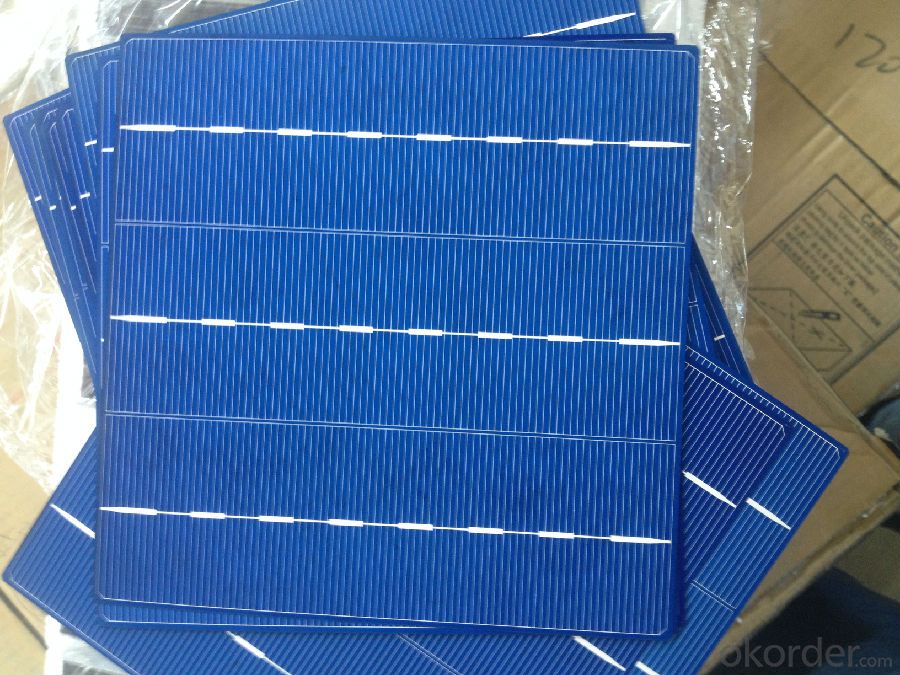
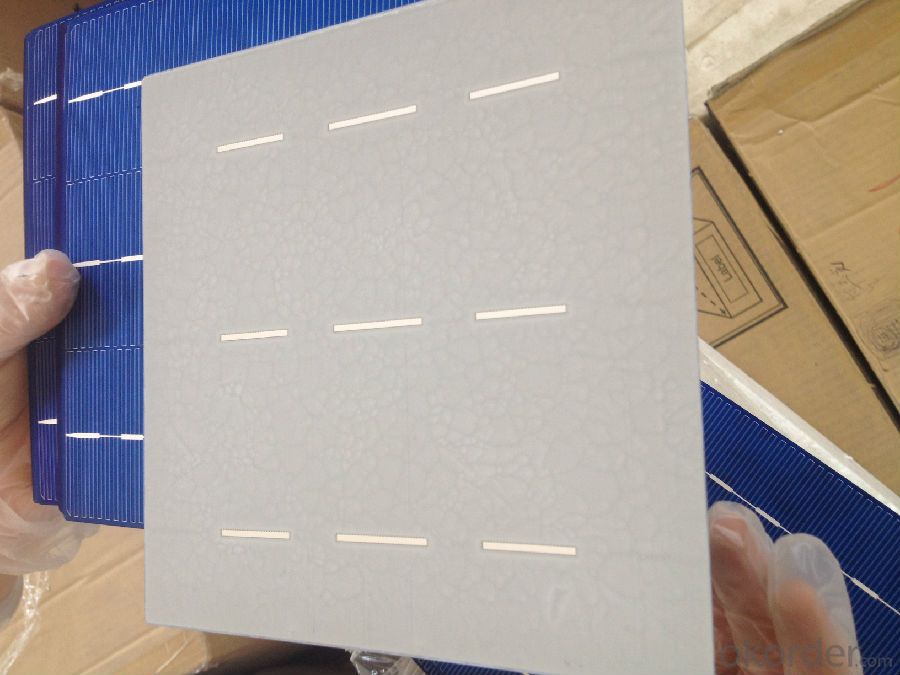
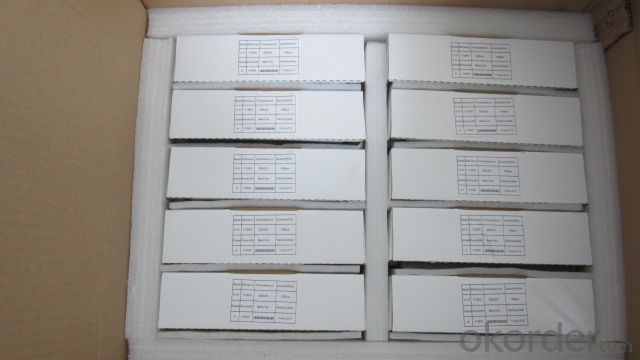
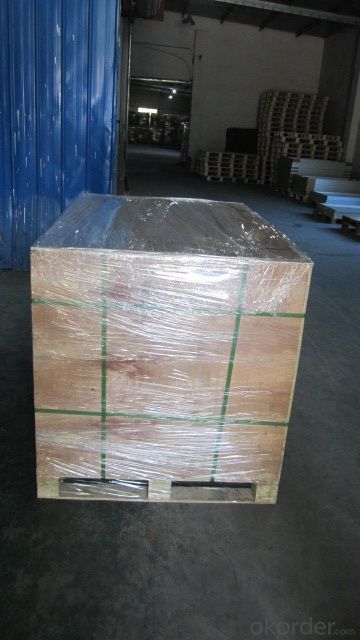
FAQ
We have organized several common questions for our clients,may help you sincerely:
①What price for each watt?
It depends on the efficiency of the solar cell, quantity, delivery date and payment terms.
②How long can we receive the product after purchase?
In the purchase of product within three working days, We will arrange the factory delivery as soon as possible. The pecific time of receiving is related to the state and position of customers.Commonly 7 to 10 working days can be served.
③Can you provide the peripheral products of the solar panels, such as the battery, controller, and inverter? If so, can you tell me how do they match each other?
Yes, we can, we have two companies for solar region, one is CNBM International, the other is CNBM engineering Co.
We can provide you not only the solar module but also the off grid solar system, we can also provide you service with on grid plant.
④What is your warranty of solar cell?
Our product can promise lower than 0.3% open box crack, we support claim after opening the box if it has crackm color difference or sth, the buyer should give pictures immediately, we can not accept the claim after the solar cell has assembled to solar panel.
• Timeliness of delivery
• ⑤How do you pack your products?
We have rich experience on how to pack the solar cell to make sure the safety on shipment, we could use wooden box or pallet as buyer's preference.
⑥ Can you do OEM for us?
Yes, we can.
Brief introduction of Sun Solar Cell Power System
Sun solar cell power systems, also known as solar power systems, solar energy is converted to electrical energy through the solar charge controller to power the load, while to the battery pack.
Solar power generation systems, also known as solar power systems, solar energy is converted to electrical energy through the solar charge controller to power the load, when to charge the battery; in the absence of sunlight through the solar charge controller from the battery to the DC load, but also directly to the battery while the individual inverter power supply, through a separate inverter is inverted into AC to AC load powered by.
Solar power system consists of solar batteries, solar controller, battery (group) composition. If the output power to 220V AC or 110V, also need to configure inverter.
Classification of Sun Solar Cell Power System
Solar power generation into off-grid power systems and grid systems:
1. Off-grid power systems. Mainly consists of solar modules, controller, battery composition, to an AC load, also need to configure AC inverter.
2. DC power generation system is generated through solar modules and grid-connected inverter converts AC power into the electricity grid in line with the requirements of direct access to the public grid after this. And power generation systems have centralized large-scale power plants are generally national grid station, the main feature is the power can be directly delivered to the grid by grid power to the unified deployment of the user. But this power plant investment, long construction period, large area, the development of a relatively large degree of difficulty. The small and decentralized power generation systems, especially BIPV power system, due to the small investment, quick construction, small footprint, large policy support, etc., is the grid of the mainstream.
- Q: How do solar cells perform in regions with high levels of salt spray and corrosive environments?
- Solar cells can be affected by salt spray and corrosive environments, which can degrade their performance over time. The exposure to high levels of salt spray can lead to corrosion of the cell's components, such as the metallic contacts, leading to a decrease in efficiency. However, manufacturers have developed various protective coatings and materials to mitigate the effects of salt spray and corrosion, ensuring the long-term performance of solar cells in such challenging environments.
- Q: Can solar cells be used in camping or outdoor recreational activities?
- Yes, solar cells can be used in camping or outdoor recreational activities. They are a convenient and environmentally friendly way to generate electricity in remote locations where power outlets may not be available. Solar panels can be used to charge portable devices such as phones, laptops, or camping lights, providing a sustainable source of energy while enjoying outdoor activities.
- Q: How do solar cells perform in areas with high levels of noise pollution?
- Solar cells are not affected by noise pollution as they rely solely on sunlight to generate electricity, making them effective even in areas with high levels of noise pollution.
- Q: What is the role of solar cells in powering agricultural irrigation?
- The role of solar cells in powering agricultural irrigation is to harness the energy from the sun and convert it into electricity. This renewable energy source is used to operate irrigation systems, providing power for pumps and other equipment required for efficient water distribution to crops. Solar cells offer a sustainable and cost-effective solution, reducing reliance on fossil fuels and minimizing the environmental footprint of irrigation practices in agriculture.
- Q: Can solar cells be used to power farms or agricultural operations?
- Yes, solar cells can be used to power farms or agricultural operations. Solar energy can be harnessed through solar panels or solar arrays to generate electricity, which can then be used to power various farming activities such as irrigation systems, livestock operations, or running farm machinery. Solar power offers a sustainable and environmentally friendly alternative to traditional energy sources, reducing reliance on fossil fuels and contributing to the overall sustainability of agricultural practices.
- Q: How do solar cells handle power factor correction?
- Solar cells do not handle power factor correction directly. Power factor correction is typically handled by other components in a solar power system, such as inverters or power conditioning units. These components are responsible for converting the DC power generated by solar cells into AC power that can be used in electrical systems. Power factor correction is important to ensure efficient utilization of electrical power and reduce energy losses in the system.
- Q: Can solar cells be used in off-grid applications?
- Yes, solar cells can definitely be used in off-grid applications. Off-grid systems rely on solar energy to generate electricity, making solar cells an ideal and sustainable solution for powering remote locations, cabins, boats, and other off-grid setups. Solar cells capture sunlight and convert it into electrical energy, which can then be stored in batteries for use during periods of low or no sunlight. With advancements in technology, solar cells have become more efficient and affordable, making them a practical choice for off-grid applications.
- Q: How do solar cells perform in high-altitude locations?
- Solar cells perform well in high-altitude locations due to several factors. Firstly, at higher altitudes, there is often less air pollution and cloud cover, leading to more sunlight reaching the solar cells. Additionally, the thinner atmosphere at high altitudes allows for a higher concentration of solar radiation, resulting in increased energy generation. Finally, the cooler temperatures at higher altitudes can actually improve the efficiency of solar cells, as they tend to perform better in lower temperatures. Overall, solar cells are highly effective in high-altitude locations, making them an ideal renewable energy solution in such areas.
- Q: How much space is required to install solar cells?
- The amount of space required to install solar cells can vary depending on factors such as the size and efficiency of the solar panels, the energy needs of the property, and the available sunlight. Generally, a typical solar panel requires about 100 square feet of space, but it can vary significantly based on individual circumstances and requirements.
- Q: How are solar cells installed?
- Solar cells are typically installed on rooftops or in open spaces where they can receive maximum sunlight. The installation process involves mounting the solar panels onto a structure using brackets or frames. The panels are then connected to an inverter, which converts the direct current (DC) generated by the cells into alternating current (AC) for use in homes or businesses. Finally, the system is connected to the electrical grid or battery storage, allowing for the utilization of solar energy.
Send your message to us
Inkjet Printed Solar Cells - China Wholesale A Grade High Efficiency Polycrystalline Solar Cells with Low Price
- Loading Port:
- Shanghai
- Payment Terms:
- TT or LC
- Min Order Qty:
- 5000 pc
- Supply Capability:
- 8000000 pc/month
OKorder Service Pledge
OKorder Financial Service
Similar products
Hot products
Hot Searches
Related keywords

